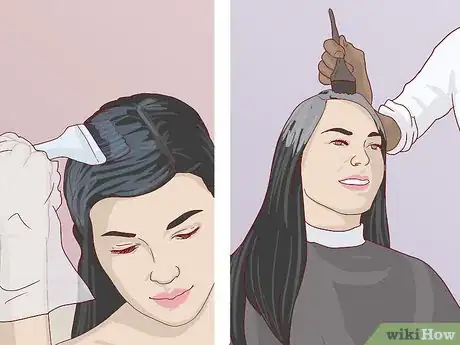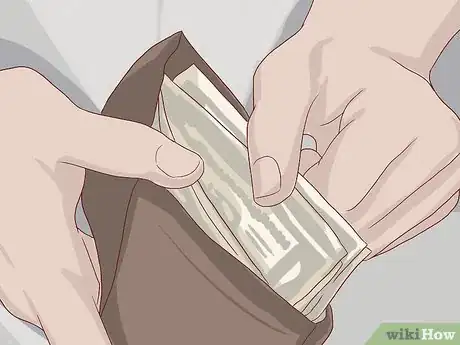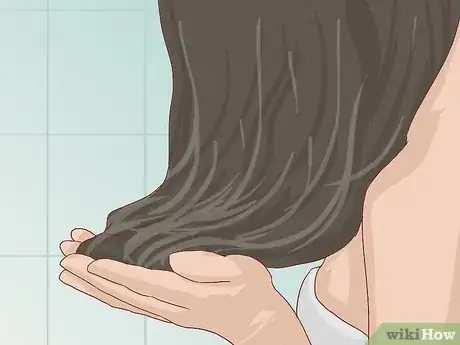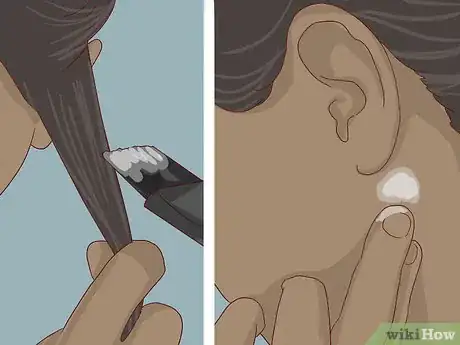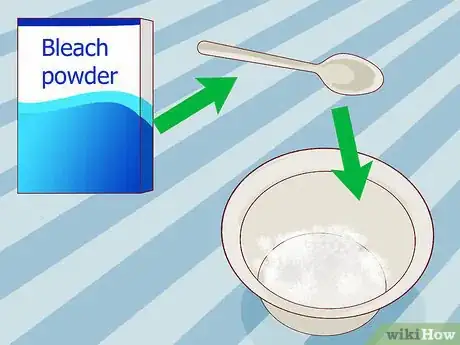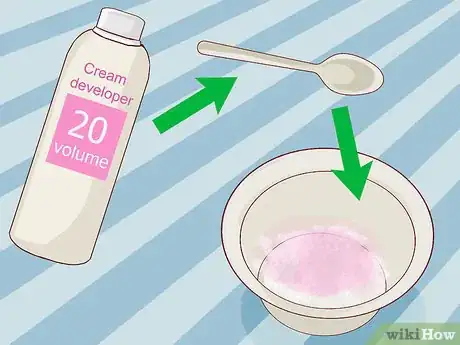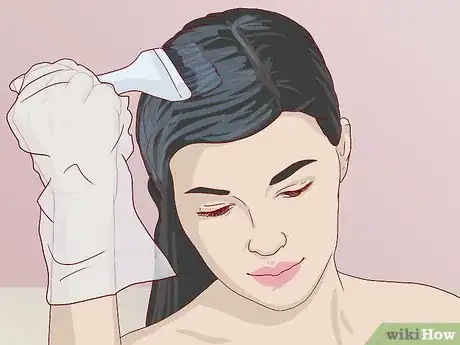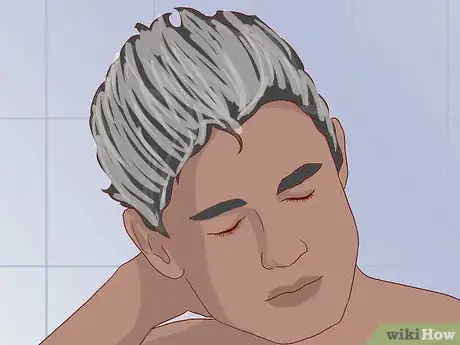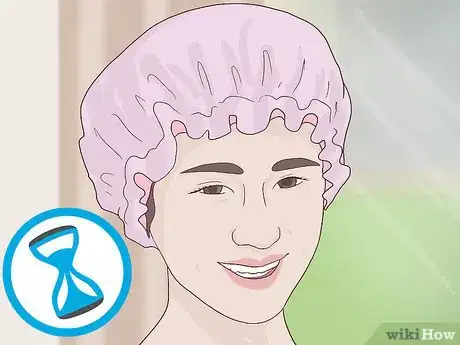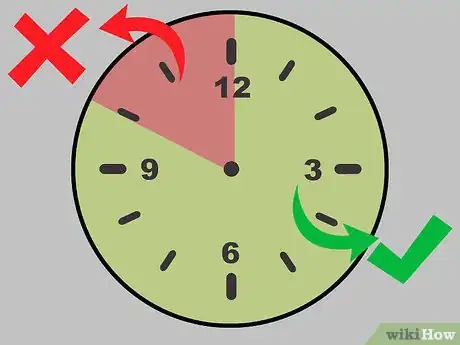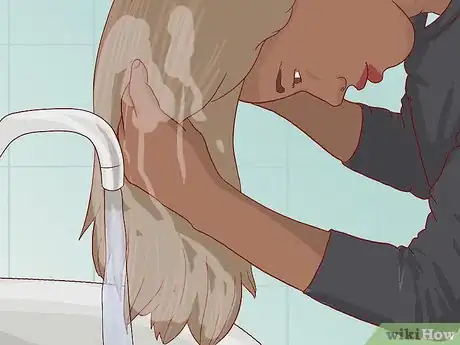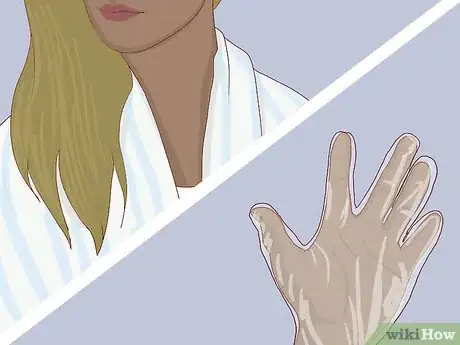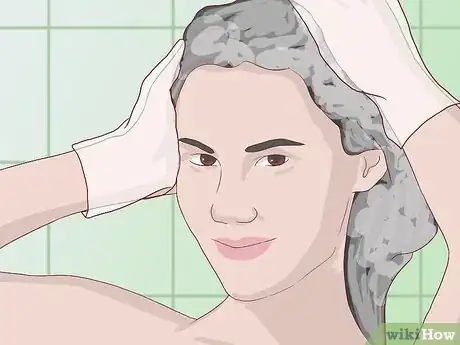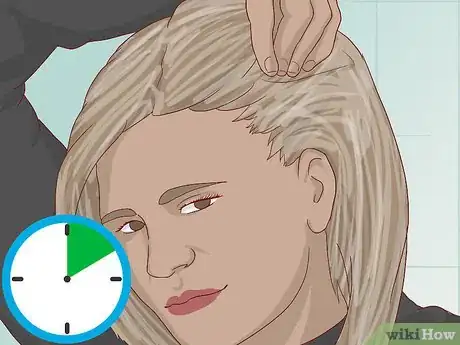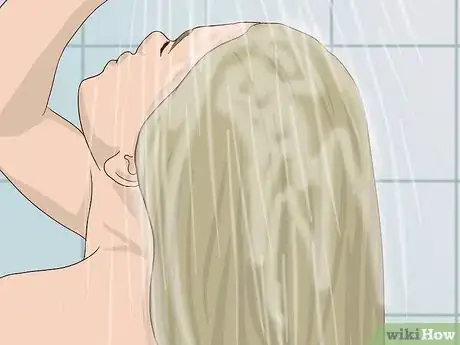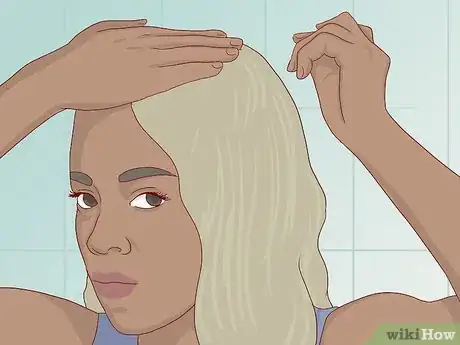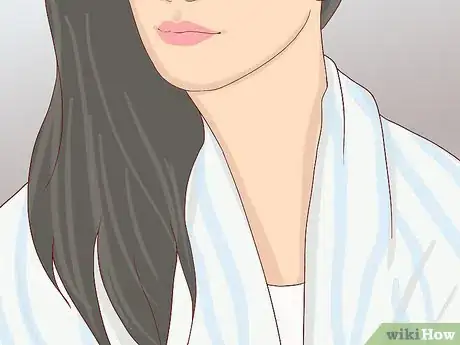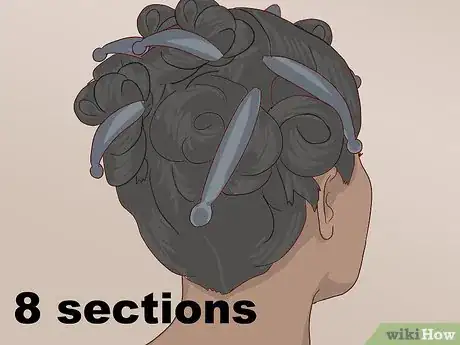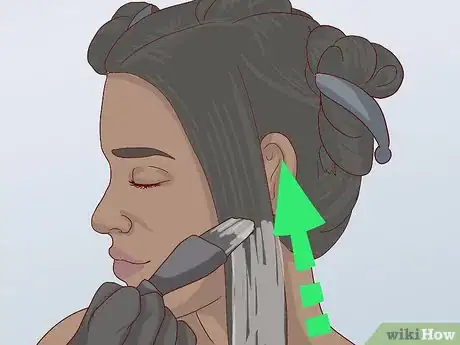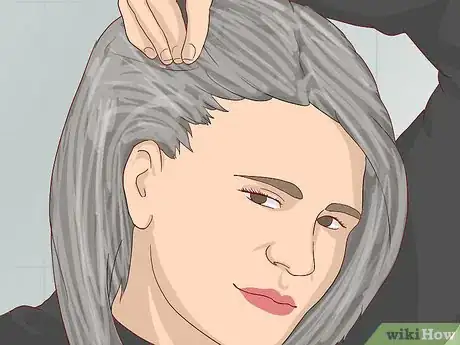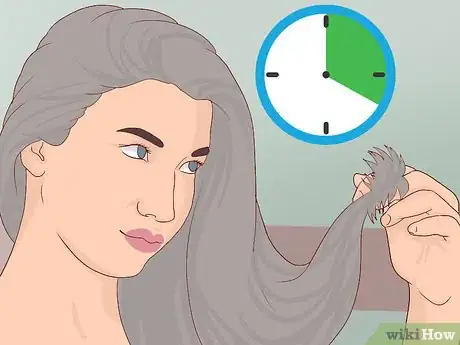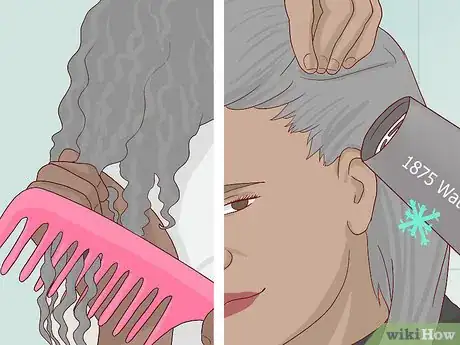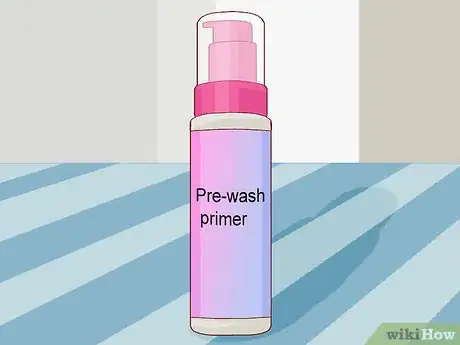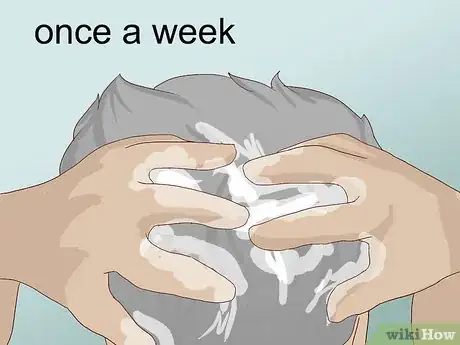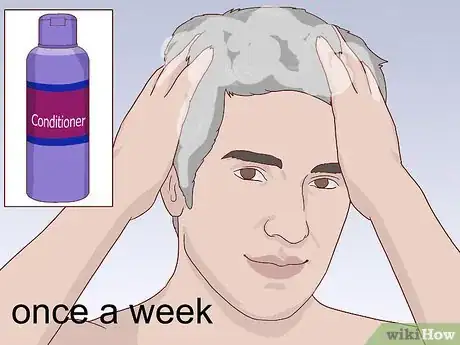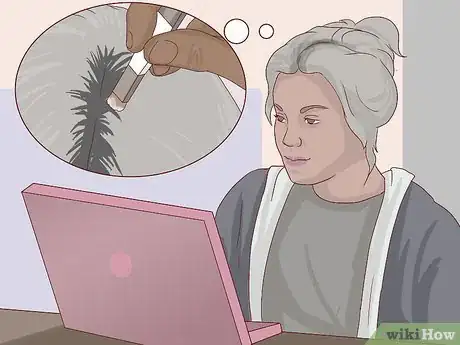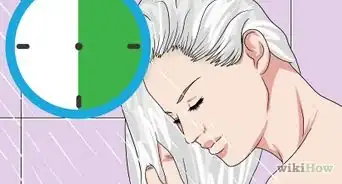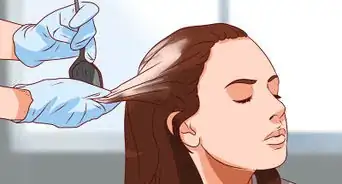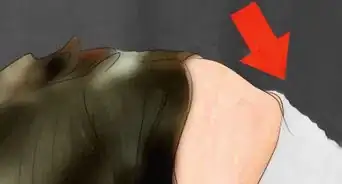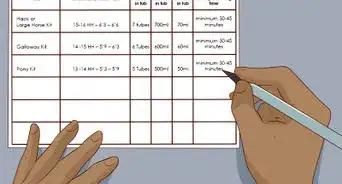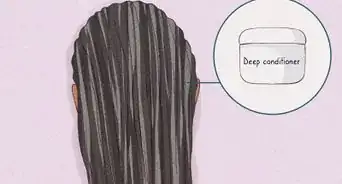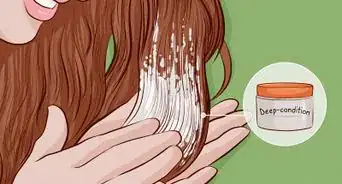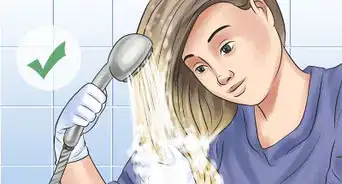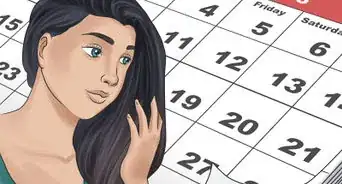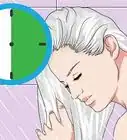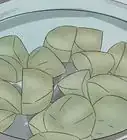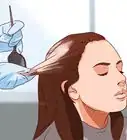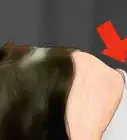This article was co-authored by Martin Nepton and by wikiHow staff writer, Amber Crain. Martin Nepton is a Professional Hair Stylist and Colorist at Bang Bang LA in Los Angeles, California. With over 11 years of experience, Martin specializes in helping clients express their Queer identity through hair. Martin offers personalized haircuts and color and style services with non-gender prices based on hair length. Martin holds a BA from the University of Québec at Montréal and is a Licensed Hair Stylist in California.
There are 14 references cited in this article, which can be found at the bottom of the page.
This article has been viewed 522,099 times.
Gray is a popular hair color choice these days, but unless you're naturally blonde, it takes time, money, and dedication. If your hair is naturally black, expect multiple bleachings and weeks of waiting before you can get the color you want. While you’re likely to get better results going to a professional salon, it’s possible to dye black hair to gray at home.
Steps
Preparing to Go Gray
-
1Choose your method wisely. Consider whether to use an at-home dye kit or professional dyes, or go to the salon. Carefully consider the costs, processes, and risks involved in each method.
- For the salon method, costs and products will vary. Check out websites of local salons or call them for pricing. If possible, talk to a stylist in person.
- Use the box kit method with caution. Read online reviews to help you choose a box kit that works best on black hair. A popular box kit is L’Oréal Paris Preference Les Blondissimes LB01: Extra Light Ash Blonde. It won’t dye your hair platinum, but may get you down to an ashy blonde in one go.[1]
- Use professional-quality products, if possible. Some professional companies require a cosmetology license in order to make a purchase, so keep that in mind.[2]
-
2Be prepared for the time and expense. Regardless of which method you choose, it will likely take multiple bleachings to achieve the gray tone that you want. Take the time and expense (i.e. multiple salon visits, multiple purchases of dye kits or professional products) into consideration before you decide.Advertisement
-
3Build your hair’s health before you go gray. In the weeks or months leading up to the bleaching, avoid using harsh hair products and heat styling tools on your hair. If your hair feels damaged, do weekly deep-conditioning masks until it feels healthy enough to be bleached.
- Use good-quality shampoos and conditioners to moisturize your hair without adding buildup or stripping your hair of its natural oils. Look for low pH, oils (argan, avocado, olive), glycerin, glyceryl stearate, propylene glycol, sodium lactate, sodium PCA, and alcohols that start with “c” or “s.”[3]
- Avoid strongly fragranced products, alcohols that begin with “prop,” sulfates, and any products that claim to add volume.[4]
-
4Purchase bleach powder at a beauty supply store. To dye your hair gray at home, you’ll need to start by bleaching it. You can buy bleach powder from a professional beauty supply store or online. It is typically sold in packets or tubs. If you plan on bleaching your hair more than once, a tub is the cheaper long-term option.
- Some bleach kits may come with bleach powder and cream developer, so if you go that route, you may not need to purchase individual products. Check the kit's packaging for details.
- Consider buying red gold corrector. Red gold correctors often come in little packages that you add to your bleach mixture to reduce brassiness. This is optional, but recommended.
-
5Purchase a 10 to 20-volume cream developer. Cream developer reacts with the powder to bleach your hair. It comes in different volumes ranging from 10 (weakest) to 40 (strongest). The higher the volume, the quicker it will turn your hair blonde, but also the more damaging it will be. Most stylists recommend using 10-volume or 20-volume. A 20-volume developer is your safest bet for effectiveness and gentleness.
- If you have fine, fragile hair, use a 10-volume developer.
- For dark, coarse hair, a 30- or 40-volume developer might be necessary.
- Do not use a 50-volume developer at home.
-
6Buy a hair toner to help eliminate brassiness after bleaching. Toners are what take your hair from yellow to white, which is the ideal base for gray. They come in a variety of shades, including blue, silver, and purple. Even if you’re not dyeing your hair at home, a toner can be used every few weeks to maintain your color.
- Use toners to neutralize unwanted colors and remove brassiness. For example, to neutralize hair that’s too golden, choose a toner shade that’s opposite gold on the color wheel, such as a blue or violet ash-based toner.
- Some toners need to be mixed with developers before being applied, while others come ready to apply.
-
7Buy a gray hair dye and the other necessary tools for home use. You can find gray hair dye at most local beauty shops or use online retailers that sell professional-quality brands. If you purchase online, pay attention to reviews. Also, pick up an applicator/tint brush, a plastic mixing bowl, a plastic spoon, gloves, hair clips, and a plastic shower cap.
- If the veins on the underside of your wrist look blue or purple, opt for a cool white gray tone. If your veins look green or yellow, go for a warmer, steely gray.[5]
- Avoid metal tools as these will react with the bleach.
Bleaching Your Hair at Home
-
1Do patch and strand tests before bleaching. A patch test is necessary to make sure that you’re not allergic to anything in the bleach mixture. A strand test will help you calculate how long you need to leave the bleach mixture on your hair. If you only do one test, do the patch test. A severe allergic reaction could be fatal.[6]
- To do a patch test, create a tiny amount of the bleach mixture and place a dab of it behind your ear. Leave it for 30 minutes, wipe off the excess, and avoid getting the skin wet for 48 hours. If there's no skin irritation after 48 hours, go ahead with bleaching your hair.
- To do a strand test, prepare a small amount of the bleach mixture and apply it to a strand of your hair. Check it every 10 to 15 minutes until it reaches the desired color. Note the time it took to reach this color.
-
2Apply coconut oil to your hair before bleaching to protect it. Rub a small amount of extra virgin coconut oil between your palms to warm it up, then massage it into your hair and scalp. Leave the coconut oil on your hair for at least 3 hours before bleaching. You don't need to wash it out before you proceed. This can moisturize and protect your hair from damage.
- Coconut oil is an effective hair moisturizer because it is made up of molecules that are small enough to penetrate the hair shaft.[7]
-
3Put on old clothes and a pair of plastic gloves. Wear old clothes that you don't mind staining and drape an old towel over your shoulders. You will also need to protect your skin from the bleach mixture, which can cause burning and irritation. Wear flexible, disposable rubber gloves to protect your hands.
- Have a small stack of old towels ready in case you need to clean the bleach mixture off your skin or elsewhere.
-
4Place the bleach powder in the mixing bowl. Using a plastic spoon, place as much bleach powder as you need in a plastic mixing bowl. The powder should come with easy-to-follow instructions.
-
5Combine the bleach powder with developing cream. Add the correct amount of developer to the bowl containing the powder, and mix them together with a plastic spoon. Aim for a thick, creamy consistency, similar to gravy.
- Unless stated otherwise on the packaging, the ratio of developer to powder should be roughly 1:1 — 1 spoonful of powder per 1 spoonful of developer.[8]
- Add a red gold corrector to the mixture, if desired. This is optional, but it can help reduce brassiness and make your hair whiter, which will help you achieve a better gray. Once the powder and developer are combined, add some red gold corrector to the bleach-developer mixture. Read the package instructions for how much you need to add.
-
6Apply the mixture to dry hair that hasn’t been washed in 24 to 48 hours. Use a tint brush to apply the mixture to your hair. Work with 1 to 2 in (2.5 to 5.1 cm) strips of hair and start at your ends, brushing the mixture upwards and leaving roughly 1 inch (2.5 cm) of roots. Work from the back of your head to the front of your head. This will make it much easier to keep track of what hair you’ve already applied bleach/dye too. After you've covered the rest of your hair, apply bleach to your roots.
- It is important to save the roots for last because the warmth of your scalp causes your roots to develop faster than the rest of your hair.
- Unless your hair is quite short, use clips to section off your hair as you work on it. Be sure to use plastic clips, since metal can react to the bleach mixture.
-
7Check that the mixture is evenly distributed on your hair. Check to ensure that your hair is fully saturated with the mixture and that it's evenly distributed by massaging your hair around your head and feeling for any spots that are drier than the rest. When you come across a dry spot, add more bleach mixture to the area and massage it in.
- Avoid massaging the mixture into your scalp to prevent irritation.
- Use a mirror to help you get a clear view of the back of your head.
-
8Cover your saturated hair with plastic wrap. You can also use a clear plastic shower cap. As the bleach works, your scalp may begin to itch and sting. This is normal. If the tingling and stinging on your scalp become too painful, remove the plastic wrap and wash out the bleach.
- Avoid the temptation to apply any heat to your hair at this point, as applying heat could end with your hair falling out completely.
-
9Check on your hair's progress every 10 to 15 minutes. After 15 minutes, check a strand of hair to see how much color has lifted. Spritz the strand of hair with water from a spray bottle and use a towel to wipe some of the bleach mixture away so that you can clearly see the color of the strand. Do not leave the bleach in your hair for longer than 50 minutes.Your hair may break off and/or fall out completely.
- If your hair still looks dark, reapply more bleach to the strand of hair, replace the plastic wrap and allow it to sit for another 10 minutes.
- Continue checking your hair every 10 minutes until your hair is completely blonde.
-
10Rinse, shampoo, and condition your hair. Remove the plastic wrap/cap and run your head under cool water until all traces of the bleach are gone. Wash it with shampoo, apply a quality conditioner, and rinse your hair thoroughly. Gently squeeze the excess water from your hair with a clean towel.
-
11Check the color and decide whether you need to re-bleach. Your hair should be a pale or bright shade of yellow. If it is yellow, proceed to the instructions for toning your hair. If your hair is orange or still dark, you will need to bleach it again, waiting at least 2 weeks between bleachings.[9]
- Remember that the darker the blonde, the darker the gray will be, so bleach your hair as light as you want your gray shade to be.
- Note that you won’t need to reapply the bleach to your roots if your roots are whiter than the rest of your hair. Just apply bleach to the parts you want to lighten further.
- Depending on how dark, coarse, and thick your hair is, it could take up to 5 bleachings to turn it pale yellow.[10]
Toning Your Hair at Home
-
1Put on a fresh pair of protective gloves. Don't use the same gloves you used during the bleaching process! Also, have a stack of towels handy and make sure your hair is towel-dried to remove any excess water after rinsing out the bleach.[11]
-
2Mix the toner and developer in a large bowl. If your toner comes premixed and ready to use, you can skip this step. In a clean plastic mixing bowl, mix the toner and developer according to the instructions on the packaging.
- The ratio is usually 1 part toner to 2 parts developer.
-
3Saturate your damp hair from root to tip with the toner. Use your tinting brush to paint your hair with the toner, following the same technique as when you applied the bleach (working from ends to roots, back to front). Be sure to saturate your hair and apply the toner evenly.
- Use a mirror to have a look at the back of your head to make sure the toner is fully covering your hair.
-
4Cover your hair with plastic wrap or a shower cap. Allow the toner to sit in your hair for the length of time specified on the packaging. Depending on the strength of the toner and the color of your hair, it could take as little as 10 minutes for your hair to go white.
-
5Check your hair color every 10 minutes. Use a towel to scrape some toner off a thin strand of hair to get a sense of what color it’s turning. If your hair’s not the desired color yet, reapply toner to that strand and put it back up beneath the plastic cap/wrap.
- Depending on the type of toner you use and how on light your hair already is, the toner could work more quickly or slowly than expected.
-
6Rinse out the toner thoroughly and wash your hair. Run your hair under cool water until all traces of the toner are gone. Shampoo and condition as normal, and gently squeeze the water from your hair with a clean towel.
-
7Examine your hair to make sure it is bleached nearly white. Let your hair air dry or, if you are impatient, dry it with your blow dryer’s coolest setting. Now that the bleaching and toning processes are complete, your hair should be white.
- If you missed a spot, wait a few days and repeat the process on the strand of hair in question.
Dyeing Your Hair Gray at Home
-
1Do patch and strand tests before dyeing. If you’re less fussy about what color of gray your hair turns out to be, you can skip the strand test. The patch test, however, is absolutely necessary, as an allergic reaction could be fatal.[12]
- To do a strand test, follow the manufacturer’s instructions for the specific dye that you buy. For a patch test, rub a small amount of developer on a patch of skin behind your ear and wait 48 hours to see if your skin gets irritated. If it does, don't use that brand of dye.
-
2Protect your clothes and skin. Wear old clothes and an old towel over your shoulders, and wear rubber gloves (vinyl and latex disposable gloves are popular). Have some old hand towels nearby in case you need to wipe the dye off your skin.
- You may even want to rub a bit of petroleum jelly or thick moisturizer around your hairline to prevent the dye from staining your skin.
-
3Prepare the dye mixture according to the product's instructions. Exactly what you need to do to prepare your dye mixture will depend on the specific type of gray hair dye that you purchased. Use a plastic bowl and a tint brush to mix your dye.
-
4Dampen and section your hair for dyeing, if necessary. Read the instructions on the box to learn whether your hair needs to be wet or dry during application, as this differs depending on which dye you use. If your hair is long, clip it into 8 sections—4 on each side—moving vertically from the nape of your neck up to your forehead.
- If your hair is thick, you may need to do more sections.
-
5Apply the dye to the lengths of your hair. Using the tint brush, brush the dye on to 2 in (5.1 cm) sections of your hair, moving up from the ends toward the roots. Stop roughly a 1⁄2 to 1 inch (1.3 to 2.5 cm) from your roots.
- The warmth from your scalp causes the color on your roots to process more quickly, so save your roots for last.
-
6Apply the dye to your roots and check coverage. Once the lengths of your hair are covered in dye, go back around your head and cover all of your roots. Then, use a mirror to check the back of your head and ensure even application. Gently work your hands through your hair and feel for even distribution.
- If you come across any spots that feel dry, add more dye.
-
7Cover your hair with plastic wrap and check the color after 20 minutes. The processing time will differ depending on which dye you’re using. 30 minutes is an average processing time. Check the color after 20 minutes to see how it's progressing. To do this, wipe a small amount of color off a strand with a towel.
- If you’re happy with the color, wash out the dye. If you’d like it to be richer, leave it on longer. Make sure you don’t go over the recommended processing time.
-
8Wash the color out thoroughly and gently. Once the color has processed, rinse it out with cool water, then shampoo and condition as normal. After washing your hair, gently squeeze the water out with a towel — don’t rub your hair quickly or be otherwise be rough with your hair while drying it. You’ll also want to avoid heat styling it for as long as possible after dyeing it.
- Ideally, you’ll avoid heat styling your hair altogether.
Caring for Your Gray Hair
-
1Be very gentle with your hair. Bleached hair is fragile and damaged hair, even if it is in the best condition it can be. Take care of your hair, don't shampoo it if it feels dry, and don't go overboard on the brushing, straightening, and curling.
- Most of the time, let your hair air dry. If you must blow-dry your hair, be sure to use the coolest setting.
- Avoid applying heat or otherwise manipulating your natural hair texture as much as possible, as this can cause your hair to break off — you could end up with chunks of hair sticking out from your head that are only 1–2 inches (2.5–5.1 cm) long.[13]
- If you simply must straighten your hair, you can achieve a straightening effect with a blow dryer and a round brush — do this as an alternative to using a straightener. If done properly, this technique should eliminate the need to use a straightening iron.[14]
- Comb your hair with a wide-tooth comb.[15]
-
2Treat your hair with a pre-wash primer to protect the color. Bleached hair is porous and can be easily discolored by water. Priming your hair before you wash can help repel the water and protect your color.
- Pre-wash primers can be purchased at salons, beauty supply shops, drugstores, and online.[16]
-
3Limit washing your hair to once or twice weekly. Shampoo strips your hair of its natural oils, and your bleached hair will likely need all the oil it can get. If you regularly work out/sweat or use a lot of products in your hair, you can likely bump this up to twice a week.
- You can also substitute dry shampoo for a wash.
- When you dry your hair, gently pat and squeeze it with a towel — don’t rub the towel over your hair.[17]
-
4Use good-quality purple shampoo and conditioner. Purple shampoos and conditioners specifically made for gray hair can help keep it toned and reduce the chances of some of your strands fading to yellow/blonde. If these aren't available to you, at least buy shampoos and conditioners that are designed for color-treated hair.[18]
- It's best to use professional shampoos and conditioners rather than drug store brands. Ask your stylist to recommend products formulated for gray or bleached hair.
-
5Deep condition your hair at least once a week.[19] Purchase a good deep-conditioning treatment from a salon or a beauty supplies shop. Avoid drugstore brands as these may only coat your hair, leaving it feeling waxy and weighed down.
- Ask your stylist to recommend a professional deep conditioning treatment.
- A good hair oil will keep your hair looking softer and less frizzy. Some people swear by extra virgin coconut oil to reduce frizz and help condition their hair.
-
6Touch up your roots and hair when the color fades. The process for bleaching, toning, and dyeing your roots is almost exactly the same as for doing your entire head. The only difference is that you’ll be doing just your roots, and not the rest of your hair.
- Renew your color when your roots are 1 inch (2.5 cm) at the longest. If you let your roots grow longer than that, it may be more difficult to touch them up without having them clash with the rest of your hair.
- If the rest of your color needs a touchup, apply toner to all of your hair, rinse it out, and apply gray dye to your hair. This time, start at the roots and work down since the roots will need more color.
-
7Limit your use of heat-styling tools to protect your hair. You may not be able to avoid hairdryers, straighteners, and curling irons completely, which is fine! Just be sure to use a good heat protectant on your hair before using heat-styling tools. These come in sprays, creams, and mousses, and are available at your local beauty supplies shop or salon.
- To keep your hair as healthy as possible, use only styling products that will moisturize your hair. Avoid anything that provides lift or volume, as this will dry out your hair.[20]
Expert Q&A
Did you know you can get premium answers for this article?
Unlock premium answers by supporting wikiHow
-
QuestionHow do you use toner for hair?
 Laura MartinLaura Martin is a Licensed Cosmetologist in Georgia. She has been a hair stylist since 2007 and a cosmetology teacher since 2013.
Laura MartinLaura Martin is a Licensed Cosmetologist in Georgia. She has been a hair stylist since 2007 and a cosmetology teacher since 2013.
Licensed Cosmetologist
-
QuestionCan you dye black hair blonde?
 Laura MartinLaura Martin is a Licensed Cosmetologist in Georgia. She has been a hair stylist since 2007 and a cosmetology teacher since 2013.
Laura MartinLaura Martin is a Licensed Cosmetologist in Georgia. She has been a hair stylist since 2007 and a cosmetology teacher since 2013.
Licensed Cosmetologist
-
QuestionHow do you cover grey hair naturally?
 Laura MartinLaura Martin is a Licensed Cosmetologist in Georgia. She has been a hair stylist since 2007 and a cosmetology teacher since 2013.
Laura MartinLaura Martin is a Licensed Cosmetologist in Georgia. She has been a hair stylist since 2007 and a cosmetology teacher since 2013.
Licensed Cosmetologist
Warnings
- Bleach can damage your hair — be careful and keep it well conditioned!⧼thumbs_response⧽
- Swimming in chlorinated water can turn your hair a greenish color. If you must swim, apply a conditioner to your hair and place it in a swimming cap before getting in the water.⧼thumbs_response⧽
- Do not bleach your hair right after washing it. You have removed the oils that protect your scalp, so your scalp and hair will be a lot worse for wear than if you wait at least 24 hours.⧼thumbs_response⧽
- Be patient with your hair. If you try to go too white too fast, you could end up causing hair breakage, hair loss, or chemical burns.[22] It may take several weeks to achieve gray hair safely.⧼thumbs_response⧽
- Avoid getting hair dye on your skin to prevent staining.⧼thumbs_response⧽
- Keep bleach off of your skin at all costs, as it can irritate and burn you. Always use gloves.⧼thumbs_response⧽
Things You'll Need
- Bleach powder
- Developer
- Red gold corrector
- Hair toner (plus possibly developer)
- Gray hair dye
- Toning shampoo
- Tint brush
- Mixing bowl
- Gloves
- Towels
- Plastic wrap
References
- ↑ https://www.youtube.com/watch?v=fs4GTjI57iQ
- ↑ http://www.xovain.com/hair/bleaching-black-hair-white-blonde-2
- ↑ http://www.webmd.com/beauty/hair-repair/ingredients-dry-hair?page=1
- ↑ https://www.aad.org/stories-and-news/news-releases/getting-past-the-hype-dermatologist-untangles-common-hair-care-misconceptions
- ↑ http://www.dailymail.co.uk/femail/article-3062296/Five-women-dye-hair-grey-FEMAIL.html
- ↑ http://www.theguardian.com/lifeandstyle/2011/nov/28/could-hair-dye-kill-you
- ↑ http://www.today.com/food/10-ways-use-coconut-oil-separating-myths-miracles-t9451
- ↑ https://www.haircrazy.com/articles/beginner-guides/bleaching-your-hair/
- ↑ http://articles.latimes.com/2013/jul/15/image/la-ig-paves-platinum-20130714
- ↑ http://articles.latimes.com/2013/jul/15/image/la-ig-paves-platinum-20130714
- ↑ https://www.youtube.com/watch?v=oFonMgXUtNk&feature=youtu.be&t=170
- ↑ http://www.theguardian.com/lifeandstyle/2011/nov/28/could-hair-dye-kill-you
- ↑ http://articles.latimes.com/2013/jul/15/image/la-ig-paves-platinum-20130714
- ↑ http://www.xojane.com/beauty/how-to-avoid-damaged-bleached-hair
- ↑ http://www.xojane.com/beauty/how-to-avoid-damaged-bleached-hair
- ↑ http://fashionista.com/2014/06/dark-hair-platinum-bleach-blonde
- ↑ http://www.xojane.com/beauty/how-to-avoid-damaged-bleached-hair
- ↑ Martin Nepton. Professional Hair Stylist. Expert Interview. 17 November 2020.
- ↑ http://articles.latimes.com/2013/jul/15/image/la-ig-paves-platinum-20130714
- ↑ http://www.webmd.com/beauty/hair-repair/ingredients-dry-hair?page=2
- ↑ http://articles.latimes.com/2013/jul/15/image/la-ig-paves-platinum-20130714
- ↑ http://articles.latimes.com/2013/jul/15/image/la-ig-paves-platinum-20130714
About This Article
Before you can dye naturally black hair gray at home, bleach your hair at home or go to a salon to have it bleached at least three times until it is as light as you want it. Next, coat your hair with a toner to take it from yellow to white. To dye your hair, start at the ends and work up towards your roots. However, to ensure your hair dyes evenly, don't dye your roots until you've covered the rest of your hair. Then, cover your hair with a shower cap for 30 minutes and rinse the dye out. Scroll down for tips from our Cosmetologist reviewer on maintaining gray hair.
